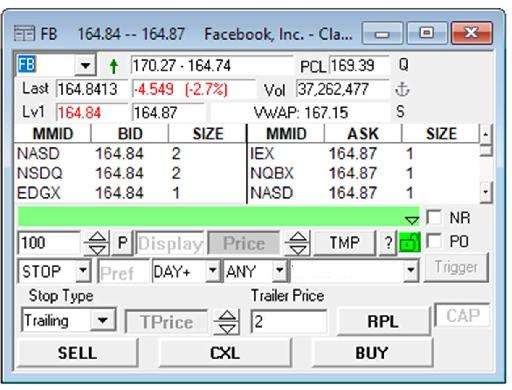Trailing Stop
A Trailing Stop order acts as a moving stop loss to protect profits, while also maximizing gains should the price continue going upward. It allows you to set a stop price at a fixed amount below the market price, called a trailing amount. If the market price rises, the stop price follows behind it. However, if the stock price falls, the stop loss price does not change. Think of it as a one-way stairway — the stop price can only take steps up. Once the stop price is hit, the order becomes a market order.
For example, I am long 100 shares of FB and the price is at $165. I place a $2 Trailing Stop order. This sets the initial stop price at $163. The price then moves up to $167. The new stop price is now $165. If the price moves down to $166, the stop price remains at $165. If FB falls to $165, a market sell order will be sent to exit the position. On the other hand, if FB continues climbing to $175, my $2 trailing amount will be right behind it the entire way up. In other words, I am specifying a maximum loss of $2, but no maximum gain. To enter a Trailing Stop order:
- Select STOP from the route dropdown
- Select Trailing from the Stop Type dropdown
- Enter 2 in Trailer Price
- Press SELL
See Figure 2.15 below for a screenshot of these steps in the appropriate window in Montage.

Figure 2.15 – Example of how to enter a Trailing Stop order in Montage.
You can also use Hotkeys to send a Trailing Stop order. Here is an example for sending a Trailing Stop order with a trailing amount of $0.50:
Share=Pos;ROUTE=STOP;StopType=Trailing;TrailPrice=0.50;TIF=DAY+;SELL=Send;
Table of contents
- DISCLAIMER:
- Table of Contents
- Chapter 1: Introduction
- Chapter 2: The Trading Tools and Platform
- Chapter 3: Building Your Trading Watchlist
- Chapter 4: Support and Resistance Levels
- Chapter 5: Price Action, Candlesticks and Trade Management
- Chapter 6: Advanced Day Trading Strategies
- Chapter 7: Risk and Account Management
- Chapter 8: Conclusion and Final Words
- Glossary